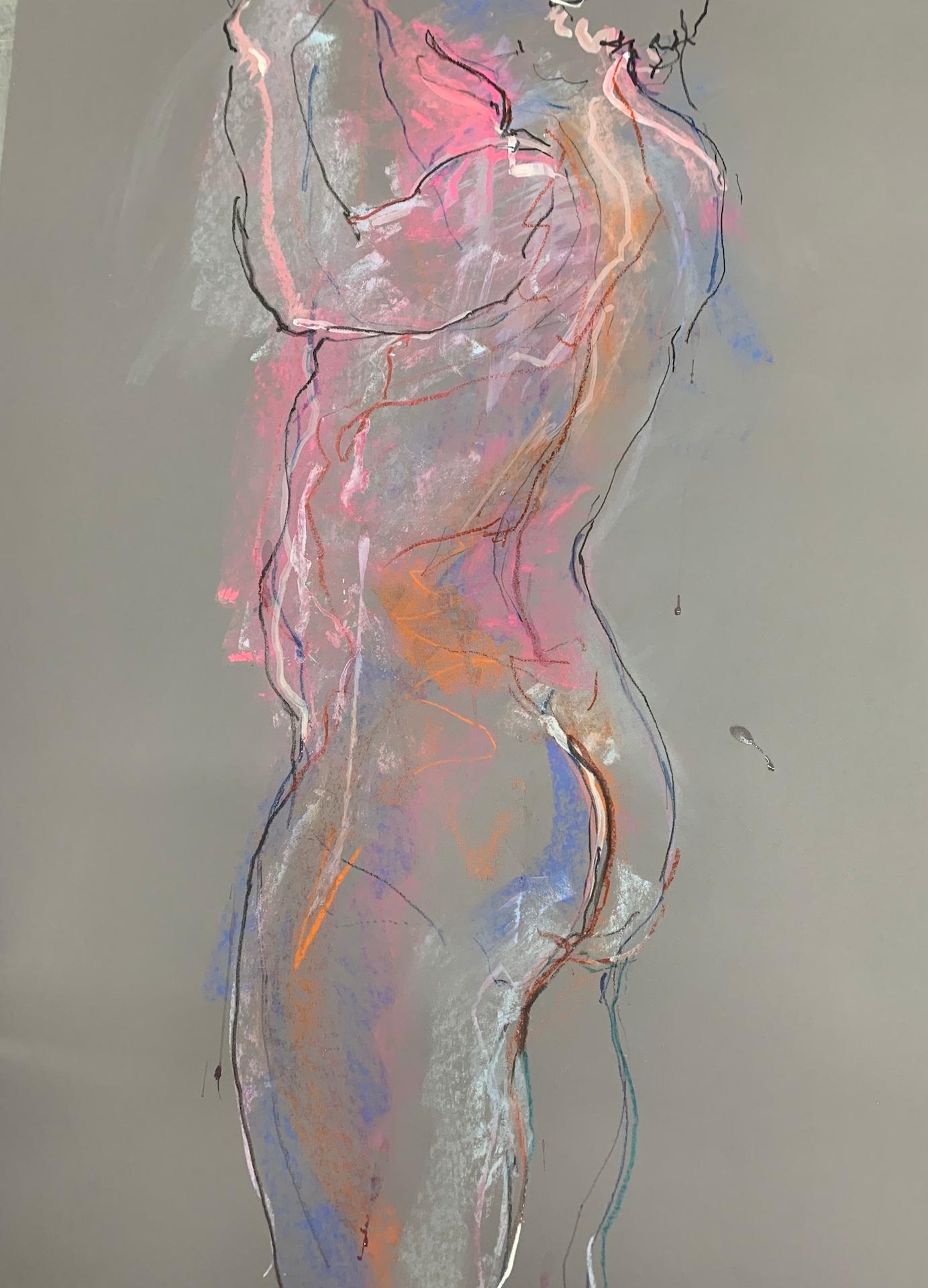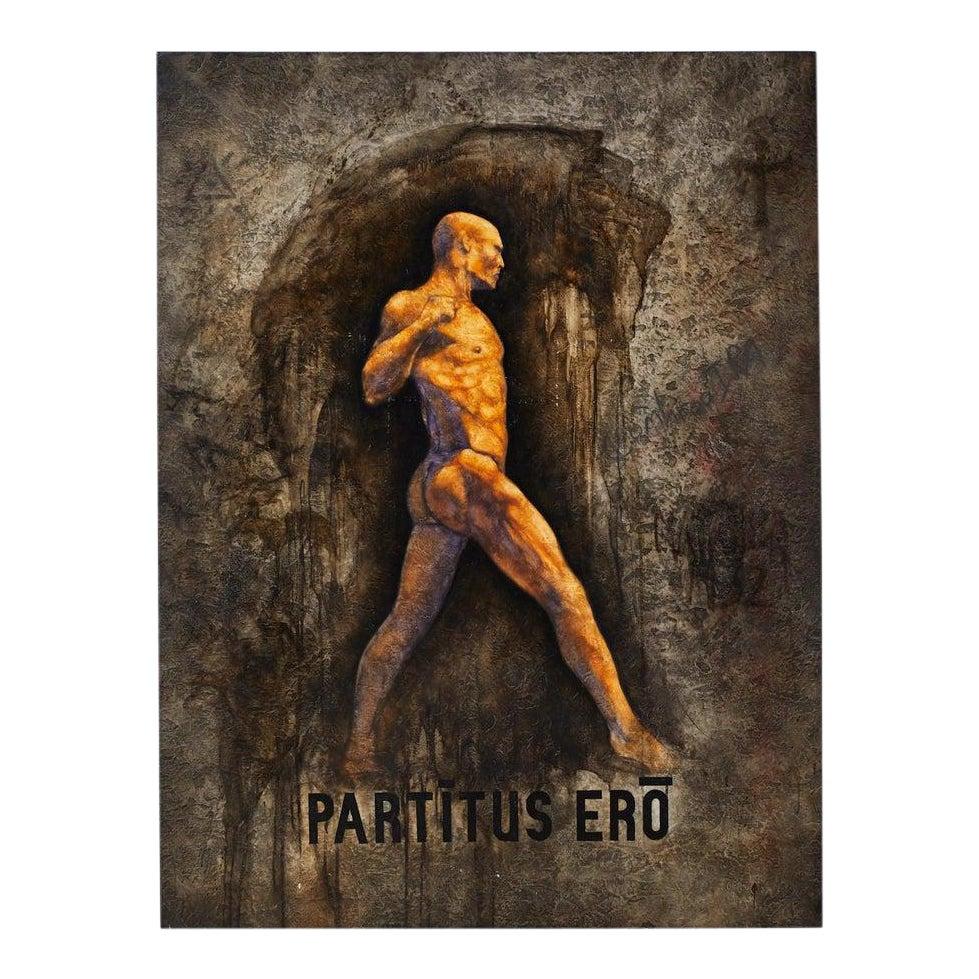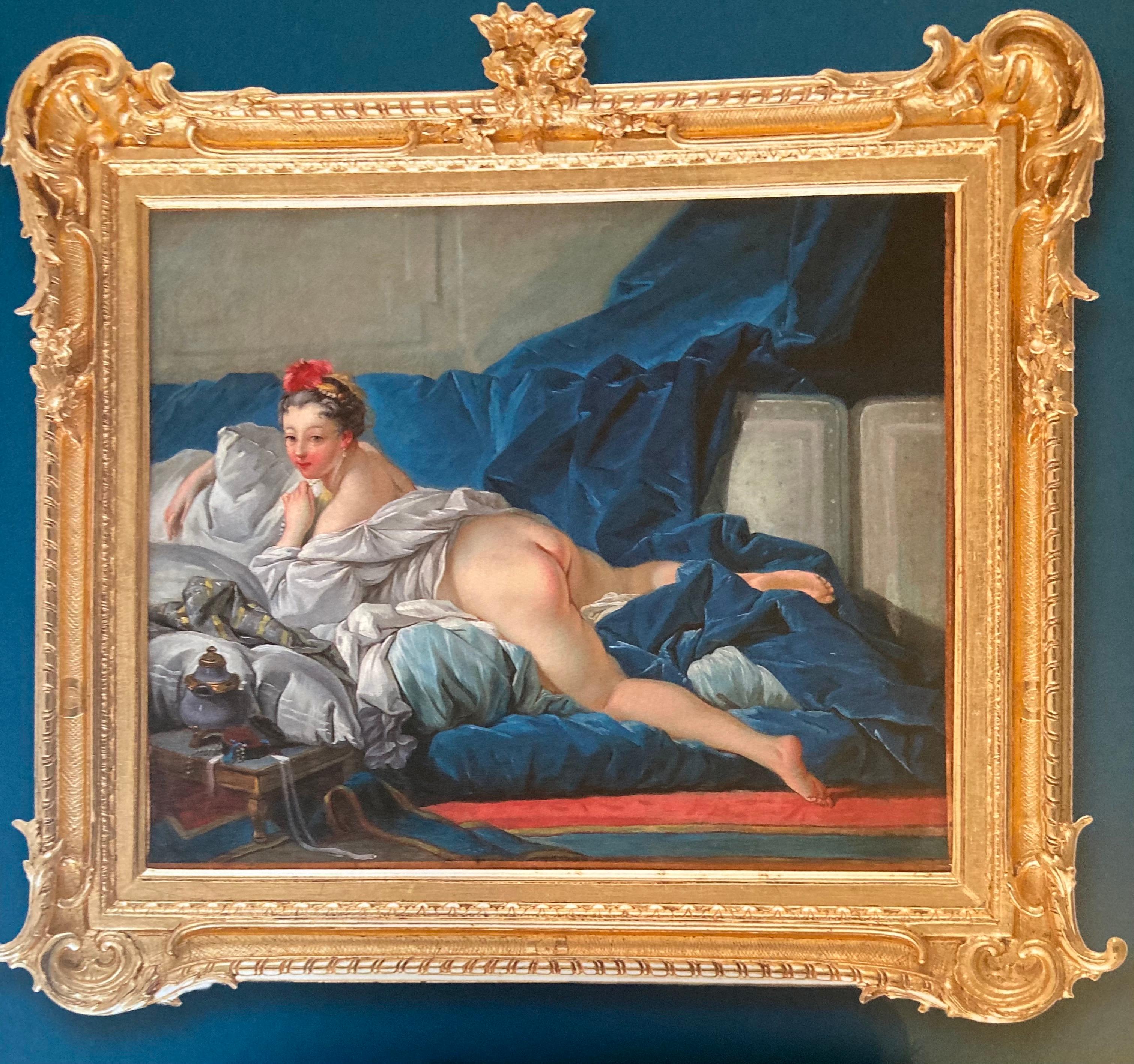Items Similar to Leda and the Swan, an early 20th Century Aesthetic Movement Allegorical Painting
Want more images or videos?
Request additional images or videos from the seller
1 of 15
Fernand Allard L'OlivierLeda and the Swan, an early 20th Century Aesthetic Movement Allegorical Painting1900's
1900's
About the Item
An early 20th century aesthetic movement allegorical oil on canvas painting of Leda and the Swan by Fernand Allard l'Olivier. Presented in plain wood frame.
Leda and the Swan is a story and subject in art from Greek mythology in which the god Zeus, in the form of a swan, rapes Leda. According to later Greek mythology, Leda bore Helen and Polydeuces, children of Zeus, while at the same time bearing Castor and Clytemnestra, children of her husband Tyndareus, the King of Sparta. In the W. B. Yeats version, it is subtly suggested that Clytemnestra, although being the daughter of Tyndareus, has somehow been traumatized by what the swan has done to her mother. According to many versions of the story, Zeus took the form of a swan and raped Leda on the same night she slept with her husband King Tyndareus. In some versions, she laid two eggs from which the children hatched. In other versions, Helen is a daughter of Nemesis, the goddess who personified the disaster that awaited those suffering from the pride of Hubris.
The father of l'Olivier was an artist who had a lithography workshop and taught watercolors at the Académie des beaux-arts de Tournai . At the age of fourteen Fernand was apprenticed to the Imprimerie Van Campenhout in Molenbeek, where he learned his father's trade.
He went to Paris in 1901 and enrolled at the Académie Julian, where his primary instructors were William Bouguereau and Jean-Paul Laurens. It was, however, Jules Adler, who had the most influence on him; encouraging him to paint ordinary people as well as historical and classical scenes. For his first works, he chose the pseudonym L'Olivier, taken from his maternal grandmother, the once popular novelist, Pauline L'Olivier. In the early part of his career, he was best known for his nudes.
In 1912, he married Juliette Rossignol, the daughter of a bookseller. The following year, she gave birth to a son, André, who would become a well known poet. During this period, he also worked as an art critic. Later, they decided to settle in Penmarch, as they felt it would be a better place to raise a family.
When World War I began, he attempted to enlist in a Belgian regiment, but was never called up. In 1916, as the war dragged on, he offered his services to the new camouflage section of the Belgian Army, then was transferred to the "Section artistique de l'armée belge en campagne". For two years, from his base in De Panne, he made forays into the trenches to sketch and paint. After the war, he and his family moved to Brussels. In 1920, he published a sketch book called Alphabet de guerre (Alphabet of the War). He continued to participate in exhibits at the Salon until 1928.
Visits to Africa
During this period, he made several trips; to Tunisia in 1923 and, in 1926, to Poland, where he created decorative paintings in Łódź. In 1928, his friend, the filmmaker Ernest Genval, paid a visit to what was then the Belgian Congo and invited L'Olivier to join him. He was able to obtain money from the Colonial Ministry, by promising to bring back artistic documents for an upcoming exhibition. He met Genval in Dar es Salaam and they proceeded to what is now Katanga Province, where he set up his workshop and travelled throughout the region, painting and collecting souvenirs. He returned to Belgium early in 1929 and prepared his works for an exhibit in Anvers.
In 1931, the world depression began to take its toll on his financial affairs. Plans for a large exhibition fell through. This prompted him to pay a second visit to Africa. In late 1932, he arrived by ship at Matadi. After spending several months visiting previously unseen places in the western Congo, he went to Léopoldville in January, 1933. There he was wined and dined by his old acquaintances until he wrote home complaining that he had no time to work. He eventually went upriver for several weeks, meeting with local dignitaries, both native and colonial. He also travelled around Lake Tanganyika and visited what is now Burundi.
By April, he had created a sufficient number of works to be planning exhibitions in Costermansville and Léopoldville, after which his wife would meet him in Tenerife on the voyage home. In June, he was heading to Léopoldville on a river tugboat, when it made an overnight stop. At one point, while he was chatting with some people, he excused himself and headed toward his cabin. A few moments later there was a loud splash. His body was retrieved from the river three days later. The autopsy revealed a fractured skull. Nobody there could say exactly what had happened.
His works may be seen at the Musée Royal de l'Armée et de l'Histoire Militaire, Musée royal de l'Afrique centrale, Musée des Beaux-Arts de Tournai, In Flanders Fields Museum, Musée des Beaux-Arts de Pau, Muzeum Sztuki Łódź and the Musées d'art et d'histoire de Genève
- Creator:Fernand Allard L'Olivier (1883 - 1933, Belgian)
- Creation Year:1900's
- Dimensions:Height: 25 in (63.5 cm)Width: 21 in (53.34 cm)
- Medium:
- Movement & Style:
- Period:
- Condition:The painting is in good overall condition but there are some small areas of paint loss and craquelure. On its original canvas and stretcher with 'keys'.
- Gallery Location:Cotignac, FR
- Reference Number:
About the Seller
5.0
Platinum Seller
These expertly vetted sellers are 1stDibs' most experienced sellers and are rated highest by our customers.
Established in 2000
1stDibs seller since 2020
153 sales on 1stDibs
Typical response time: <1 hour
- ShippingRetrieving quote...Ships From: Cotignac, France
- Return PolicyA return for this item may be initiated within 3 days of delivery.
More From This SellerView All
- Hello Hen ! Large Surrealist Contemporary Oil on Canvas.By Frank DochertyLocated in Cotignac, FRLarge surrealist contemporary oil on canvas by Scottish artist Frank McLean Docherty R.S.W. This piece whilst wonderfully colourful, playful and erotic is typical of the witty sense of humour this artist displays in all his work. The title 'Hello Hen !' ( Hen being the scottish slang for 'girl' ) is used playfully as a double-entendre. In the image we see the artist has before him a beautiful naked woman and yet chooses to paint the real hen. Also we notice that the plant's flower heads under the woman are wilting and the artist pictured (a self portrait of Docherty), an older man, suggest that the artist's desires are on the wane. Docherty likes to tease us visually and asks questions and presents conundrums to the viewer. Frank McLean Docherty was born in Glasgow , Scotland in 1942. He became a student at Glasgow School of Art in 1960 and graduated from the Department of Printed Textiles in 1964. He taught in a secondary school in the East End of Glasgow for two years, thereafter departing to work in Dublin in the Republic of Ireland as a textile designer (Marks & Spencer, Heals and Liberty of London). He was also an illustrator for a range of newspapers and an Art Director of magazines. In 1973, he was appointed Principal Teacher of Art in a Scottish High School and in 1978 was honoured by the Queen when he was appointed Member of the Royal Society of Painters in Watercolours (R.S.W.) He left education in 1994. Since that time he has developed a vision which is quite unique in Scottish Art. Bank Managers, toucans, lighthouses, penguins, bowler hats, Frank Docherty...Category
21st Century and Contemporary Surrealist Figurative Paintings
MaterialsCanvas, Oil
- "La Cagole", "The Extrovert", French Abstract Expressionist Oil on Board.Located in Cotignac, FRLate 20th century abstract Expressionist oil on board by French artist Emmanuelle Bardet. Signed bottom right and dated 1995 and titled "La Cagole" to the re...Category
Late 20th Century Abstract Expressionist Nude Paintings
MaterialsOil, Board
- Impressionist Large Scale Female Nudes in a Landscape, 'L' été a la rivière'Located in Cotignac, FRImpressionist oil painting of female nudes cavorting in a river landscape. The painting is signed with initials 'EH' bottom left and dated '66'. It is also initialled and dated to th...Category
Mid-20th Century Impressionist Figurative Paintings
MaterialsFiberboard, Oil
- Expressionist Female Nude Portrait, 'The Green Curtain' Oil on Canvas.Located in Cotignac, FRExpressionist female nude portrait by noted Scottish artist Douglas Thomson. The painting is signed bottom left and signed and titled to the back of the canvas. There is an original exhibition title and price label to the frame. Presented in original plain wood frame. A colourful and striking portrait of a female nude. Her rich red hair falling over her shoulders, her pose calm as she stares out from the canvas in a wistful way, her mouth set. Thomson has created flesh tones, wonderful contrast of colours between the sitter and the background curtain and wall and a texture to the canvas to create added interest. A really interesting and engaging portrait. Douglas Thomson was born in Greenock in 1955 and after studying at the Glasgow School of Art 1974...Category
Late 20th Century Expressionist Portrait Paintings
MaterialsOil, Canvas
- Collection of Three French Oils on Board. "La Cagole, Redoutable & La Corrida".Located in Cotignac, FRLate 20th century collection of three abstract expressionist oils on board by French artist Emmanuelle Bardet. All signed to the front and each dated 1995 and titled to the reverse. The three paintings are titled; La Cagole...Category
Late 20th Century Abstract Expressionist Abstract Paintings
MaterialsOil, Board
- 'Allez!' At the Match. Toulon Rugby Club. Large Expressionist Oil on Canvas.Located in Cotignac, FRLarge abstract expressionist oil on canvas of Toulon Rugby Club supporters at a rugby match. Unsigned. Extremely vibrant and energetic depiction of Toulon ...Category
Late 20th Century Abstract Expressionist Abstract Paintings
MaterialsCanvas, Oil
You May Also Like
- Alberto Standing 1 Judith Brenner, Sketch Painting, Original Contemporary ArtBy Judith BrennerLocated in Deddington, GBJudith Brenner Alberto Standing 1 Original Figurative Painting Mixed Media on Paper Size: H 84.1cm x W 59.4cm x D 0.1cm Sold Unframed Please note that insitu images are purely an ind...Category
21st Century and Contemporary Aesthetic Movement Figurative Paintings
MaterialsPaper, Oil Pastel, Ink, Acrylic, Watercolor
- Separation of Creation Oil PaintingBy John U. AbrahamsonLocated in Rio Vista, CADramatic oil on canvas surrealist painting by John Abrahamson (American 20th Century) depicting a nude male with the motto Partitus Ero or I wager in Latin. Abrahamson is known for h...Category
20th Century Surrealist Figurative Paintings
MaterialsOil, Canvas
- Christian Zeimert "Gentilly", 1972Located in Washington, DCPainting by French artist Christian Zeimert (b.1934 – 2020). Signed in lower right corner and titled on reverse "Gentilly". Zeimert's painted slow and meticulously. It took him se...Category
1970s Conceptual Figurative Paintings
MaterialsCanvas, Oil
- «Ta meg i mot» Figurative Oil Painting, toppless woman with blue boxing glovesLocated in Oslo, NO«Ta meg i mot» oil on canvas by Anastína Eyjólfsdóttir. A toppless woman equipped with blue boxing gloves poses by the shore. Behind her, the sky and small strip of sea create a bl...Category
2010s Contemporary Figurative Paintings
MaterialsCanvas, Oil
- PERFECT DREAM, Oil on CanvasLocated in Montreux, CHKaren Shahverdyan„Perfect Dream“ 140 X 190cm, oil on canvasCategory
2010s Surrealist Figurative Paintings
MaterialsCanvas, Oil
- Rococo Painting, The Brunette Odalisque, Nude Woman, Studio of Francois BoucherBy François BoucherLocated in Greven, DEA voluptuous woman lies prone on a divan, bearing her backside and turning her head flirtatiously to the viewer, though averting her eyes slightly, as if to maintain a coy demeanor. Surrounded by lush fabrics of deep blues, the creamy tones of her skin and dressing gown are thrown in sharp contrast, making the figure glow luminously. The whole painting is ordered by folds - of flesh, of fabric, of cushions, of the rug - inviting the viewer's eye to look closely across the topography of the canvas. One of Boucher's cabinet paintings (that is, paintings made for private collectors rather than official exhibition at the Salon), the open eroticism of this work invites a voyeuristic gaze. Although it was created for a private audience, it was later displayed at the Salon of 1767, where the critic Denis Diderot found it shocking and lascivious. Nonetheless, Boucher would later paint another iteration of this reclining pose, this time using Marie-Louise O'Murphy, a favorite mistress of King Louis XV, as his model, suggesting that the provocative composition was a stock figure for Boucher's private commissions. "The Brunette Odalisque" (French: L'Odalisque or l'Odalisque brune) is a painting of c. 1745 by François Boucher, now in the Louvre in Paris. He later produced two other works in the odalisque genre, both known as "The Blonde Odalisque". The present painting is another version of Bouchers painting which differs in minor details. The quality of the paint is very fine and the whole technique and style allows a dating to c. 1750. As Boucher's Painting was very famous there were several copies and versions which were made by his studio. The present painting can be attributed to the close circle of Boucher. The Painting is framed in a golden frame which was built in the Rococo style in c. 1990. Both the title of Boucher's painting and the objects found in the interior fix the subject as an odalisque, a concubine within the harem of the Ottoman sultan. The sumptuous textiles and exotic, decorative objects suggest early traces of Orientalism, although the figure appears European. Odalisque paintings...Category
18th Century Rococo Nude Paintings
MaterialsCanvas, Oil
Recently Viewed
View AllMore Ways To Browse
The Swan
Aesthetic Period
The Antique Swan
L S Mayer
20th Century Africa Paintings
Dining Painting Large
Early Swan
Antique Painting Decorative Arts
War Ship Painting
Paris 1900s Art
Belgian 20th Century Oil Painting
Three Swans
Dining Scene Painting
Early 20th Century Ship Paintings
Antique Painting Art Collectibles
Belgian Early 20th Century Painting
Oil Painting Early 1900s
King Of The Belgians





